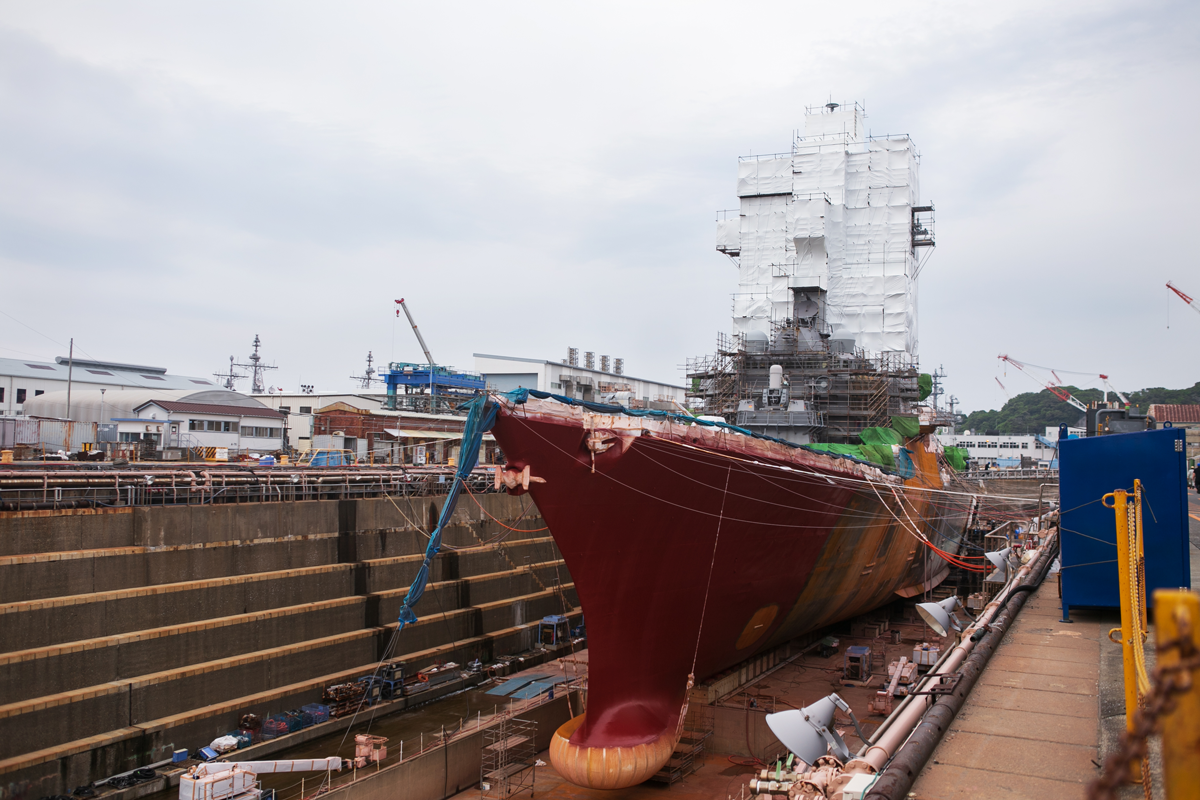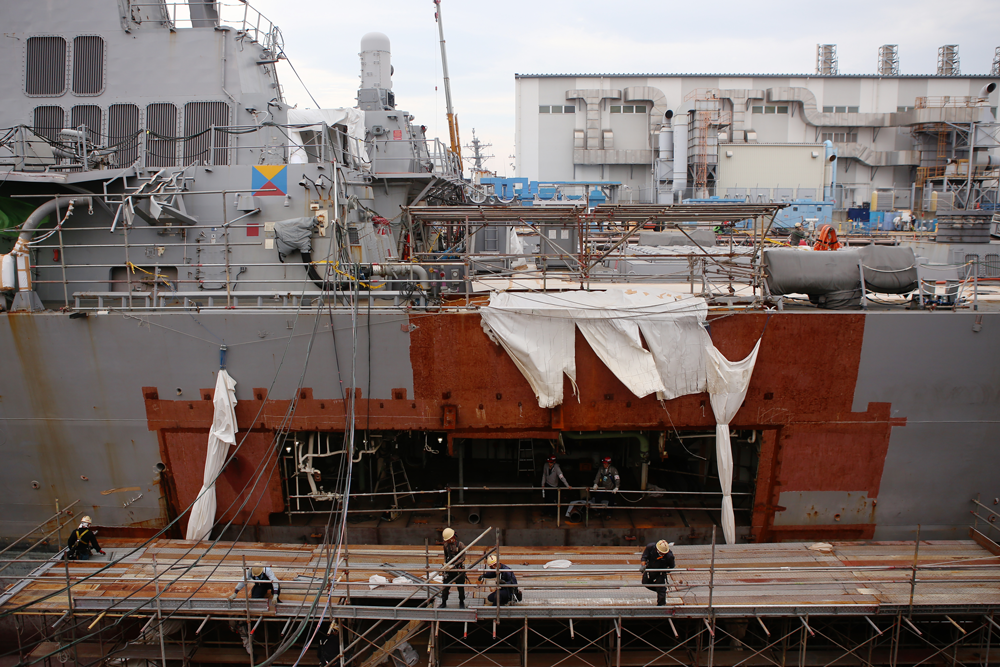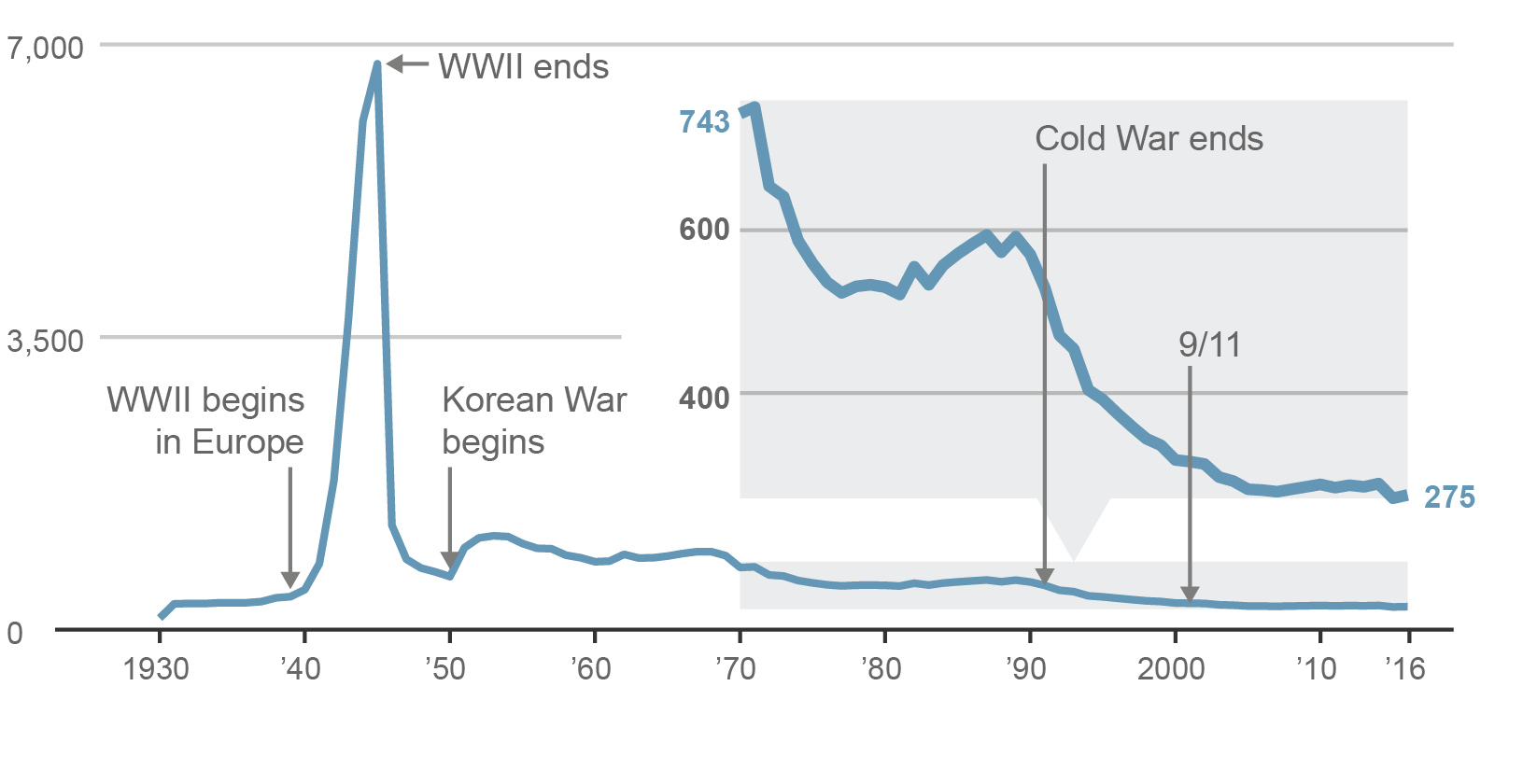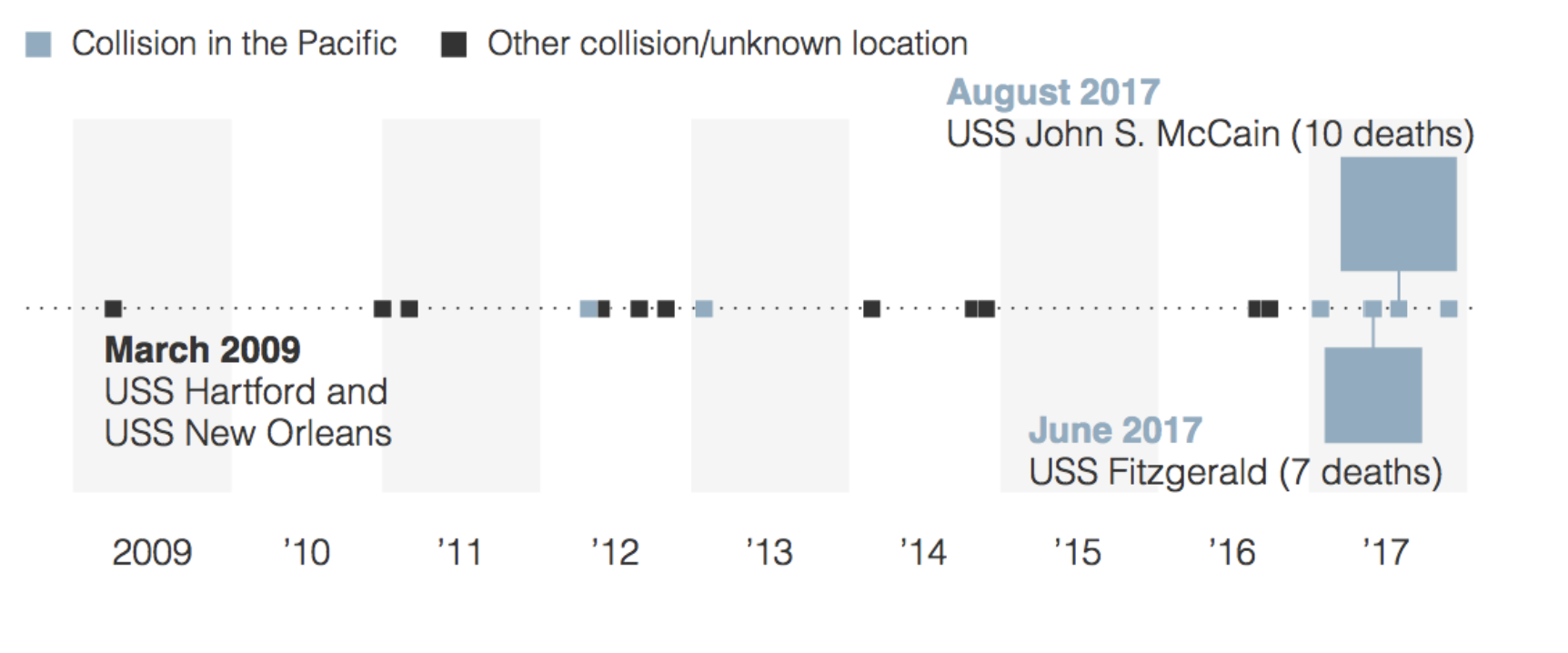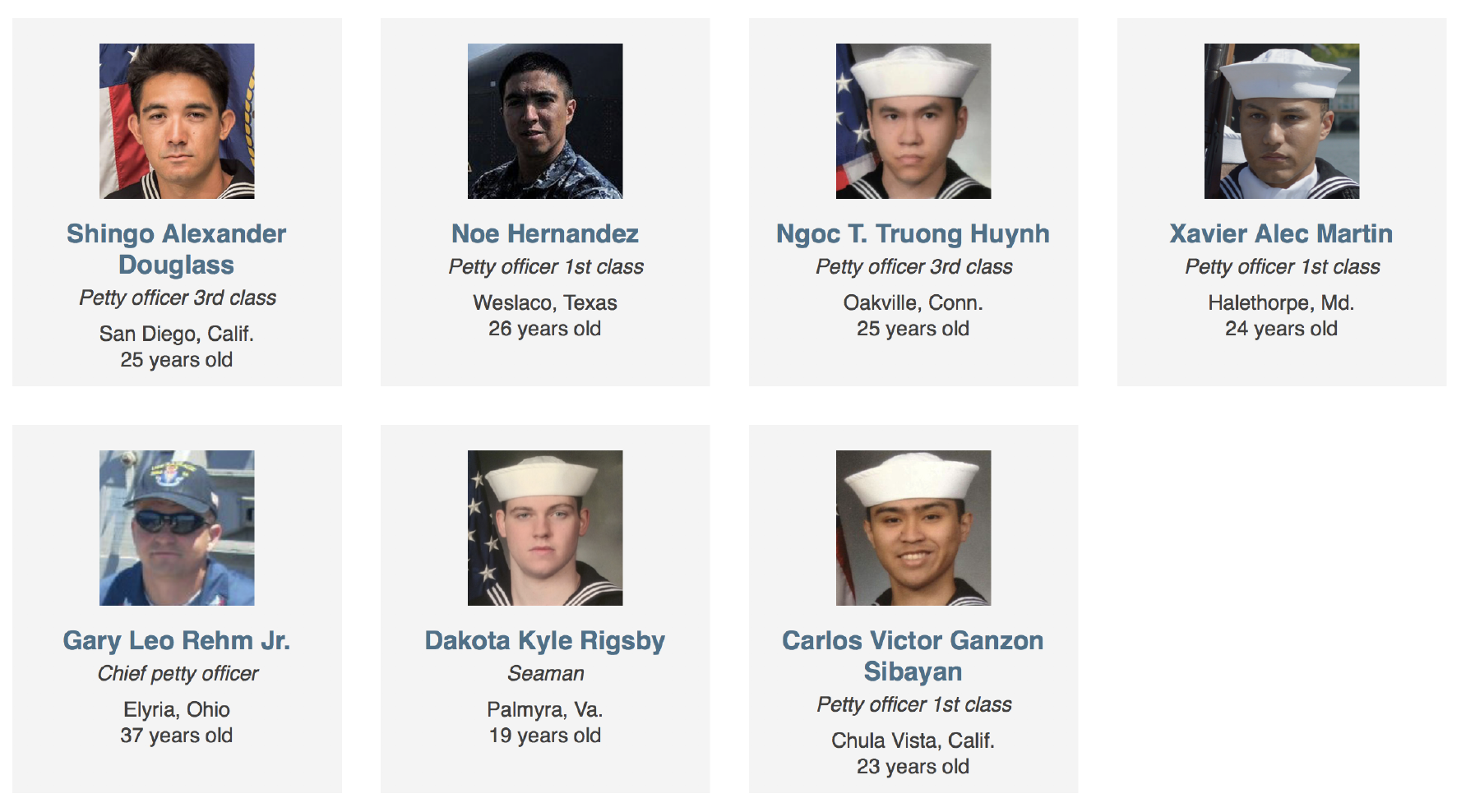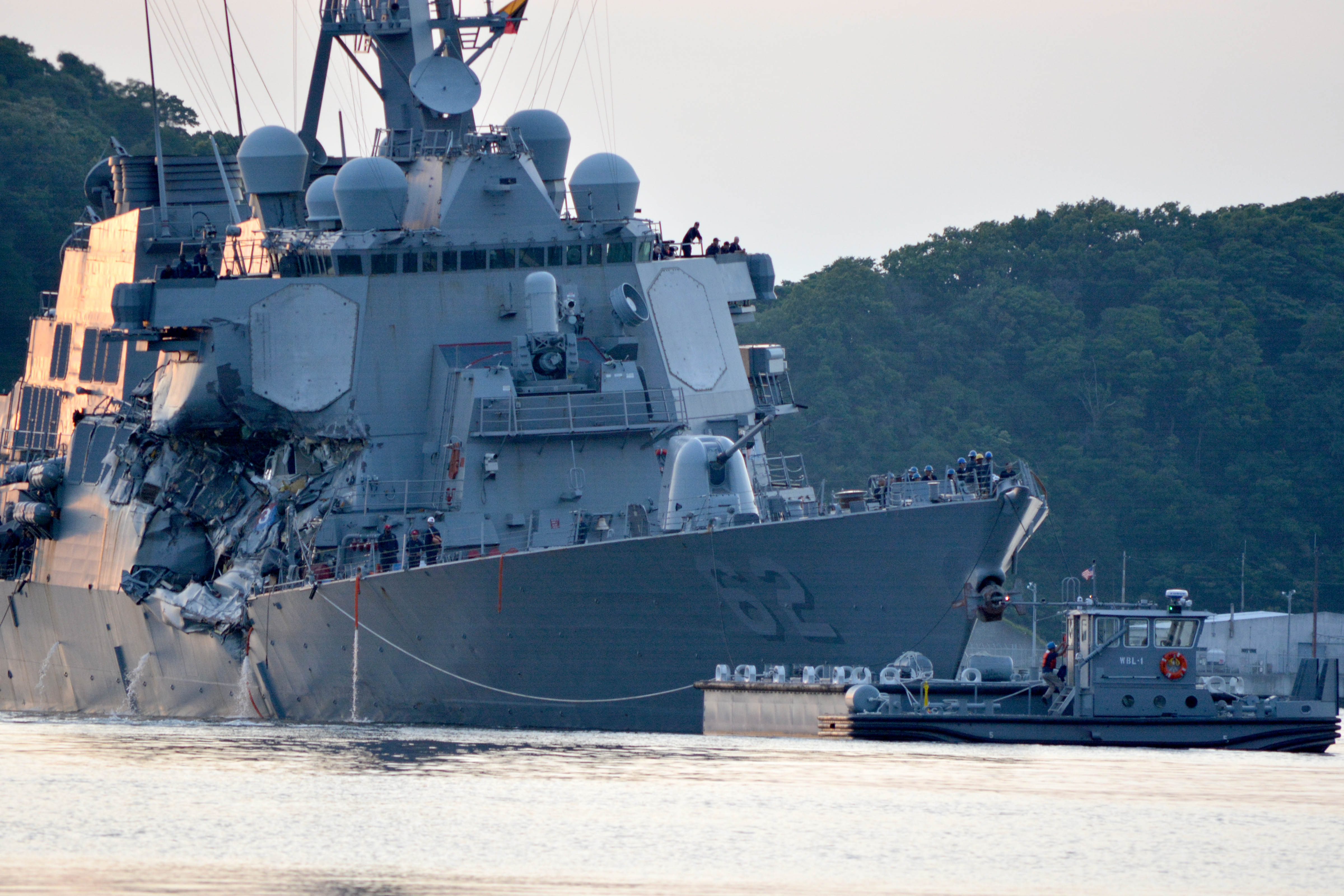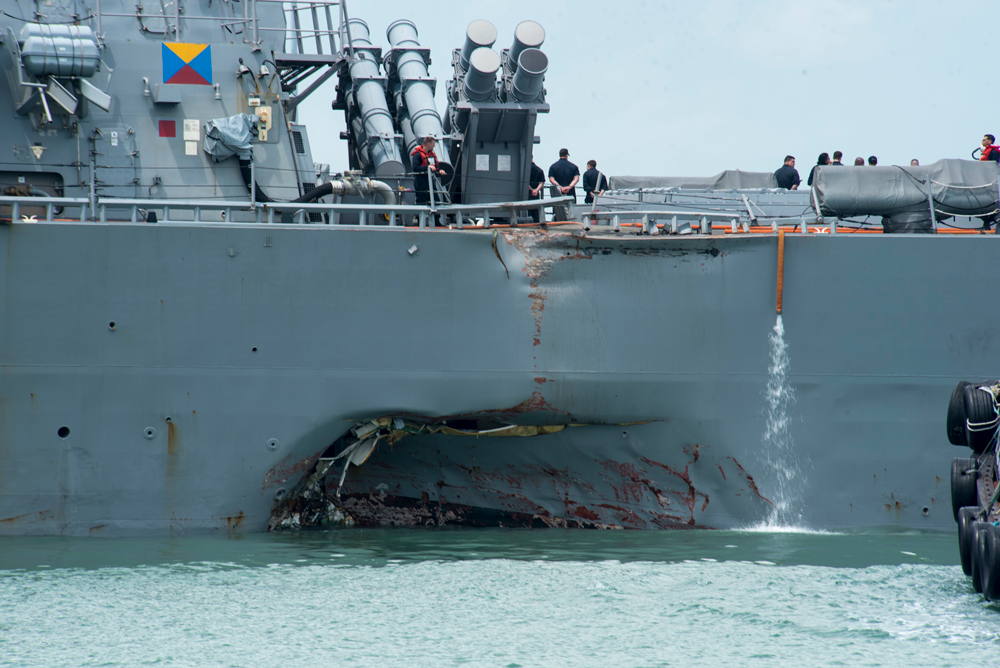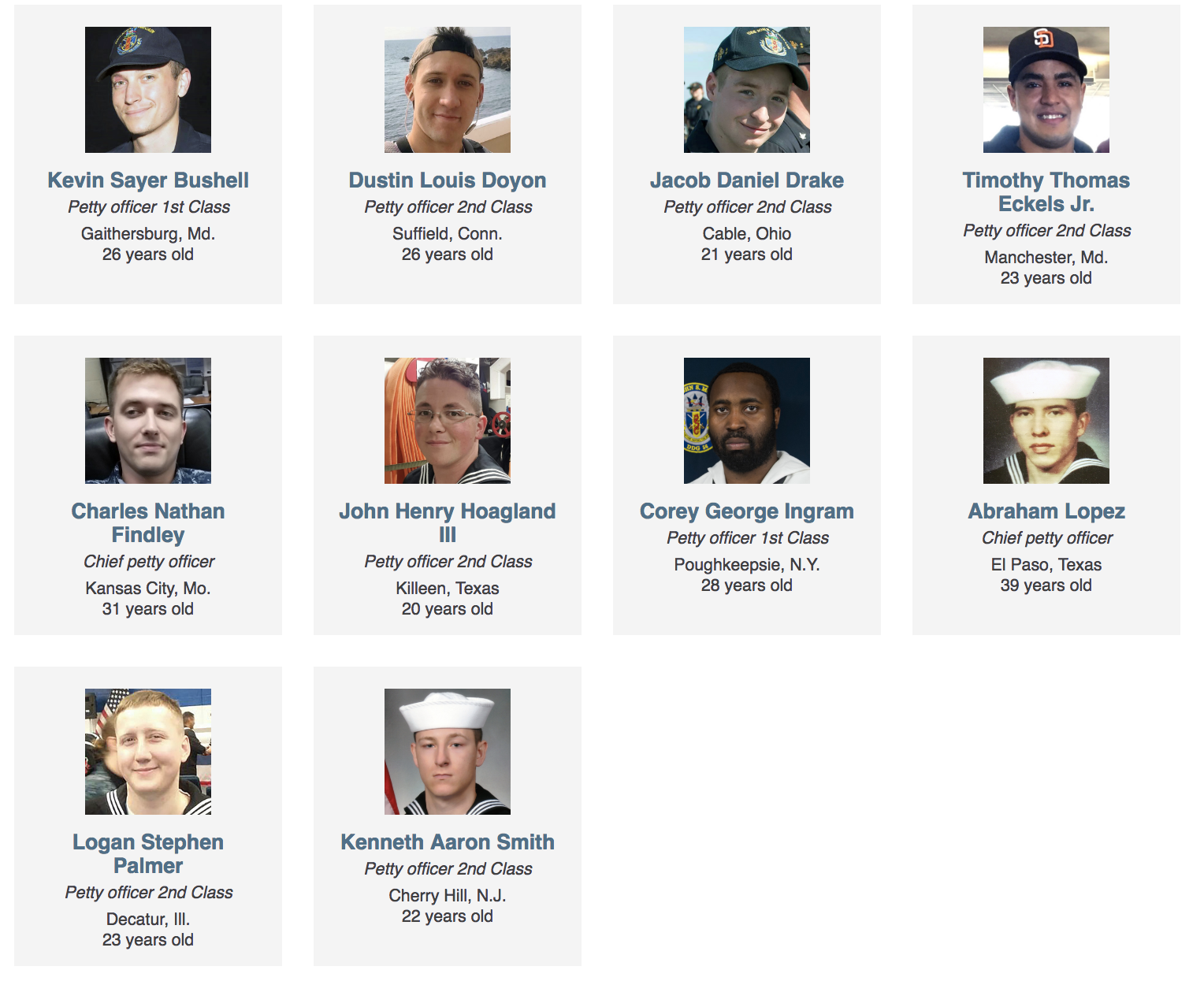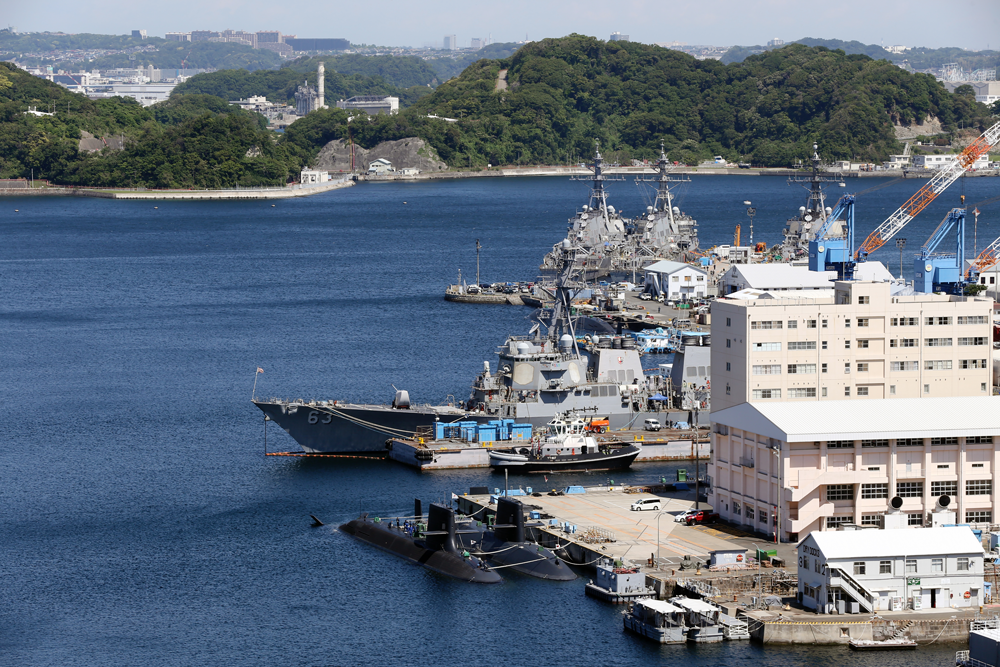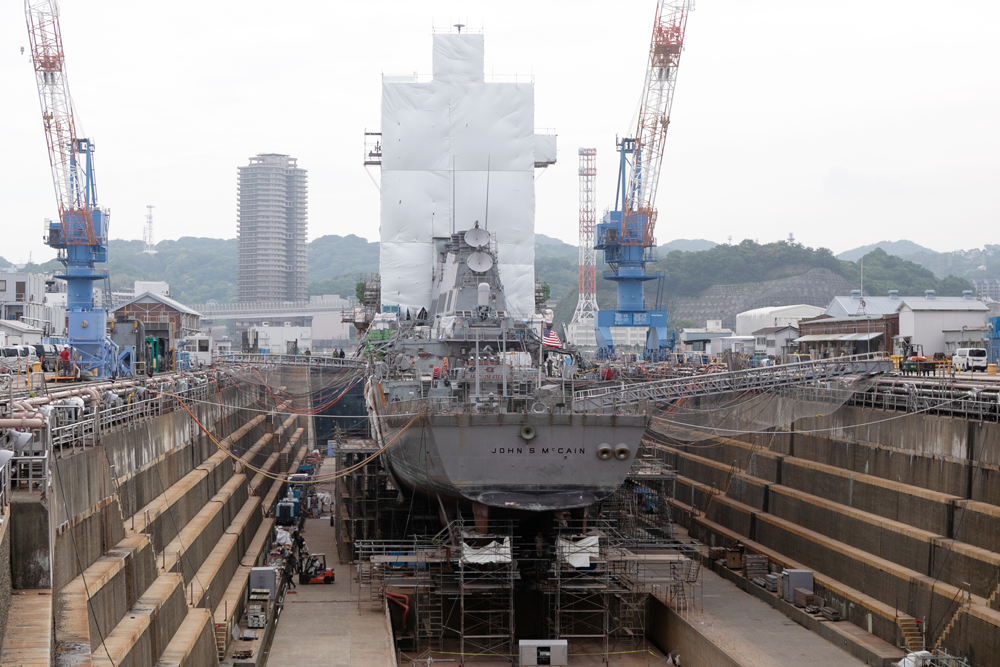Collisions reveal a Navy tragically undone by its can-do spirit
Japan-based fleet for too long had been doing more with less
By Jasmine Khayami and Elizabeth Strassner
YOKOSUKA, Japan – The USS John S. McCain sits in dry dock at the homeport of the Japan-based 7th Fleet, where workers swarm in and around the warship, urgently working to get it ready to return to sea. They will repair and paint over the gaping hole in the port side, where last summer a massive oil tanker punched into sleeping spaces, setting off a desperate scramble for survival. The 10 sailors who died had less than a minute to escape as seawater and fuel poured into their sleeping area.
The task is much the same 6,932 miles east, where the destroyer Fitzgerald is being extensively repaired in Pascagoula, Mississippi. Just two months before the McCain collision, the Fitzgerald — then homeported here in Yokosuka — was operating off the coast of Japan when it crossed into the path of a merchant ship. As with the tragedy aboard the McCain, the seven sailors who perished on the Fitzgerald had no warning and little time to get out.
Adding to the sense of alarm were another two nonfatal Navy warship crashes in the Western Pacific that occurred earlier in the year.
The Navy’s top officer – Adm. John Richardson, Chief of Naval Operations — labeled the incidents a “trend” after the McCain collision and ordered a one-day fleet-wide stand-down, a pause to ensure safe operations.
Navy-directed investigations would determine that the collisions that killed 17 sailors were the avoidable, tragic results of disturbingly inept ship handling, communications and decision-making by numerous crew members. Moreover, they would reveal that the Navy long had institutionalized tradeoffs on training and maintenance of forward-deployed forces to keep ships and sailors at sea. The increasingly hectic operations tempo – the frequency and duration of deployments – was demanded even as the number of ships and sailors was whittled down.
“As standards begin to drop, they then become acceptable and normal. I think that’s what happened,” said retired admiral Gary Roughead, former Chief of Naval Operations, in an interview. Roughead, directed by Secretary of the Navy Richard Spencer, led a strategic readiness review into the collisions and the issues affecting fleet operations.
Workers in Yokosuka, Japan repair the impact site where the USS John S. McCain was struck by merchant vessel Alnic MC on Aug 21, 2017. (Edythe McNamee / Medill)
One year after the Fitzgerald and McCain collisions, prosecutions continue against commanders and crew members of the two destroyers. Navy leaders implemented a series of changes to restore readiness to the Japan-based fleet, and more are to come. But the demand for Navy presence throughout the vast and volatile region is relentless and the stakes there are higher than in generations, particularly as China seeks to usurp long-held U.S. geopolitical dominance.
Beijing is “attempting to establish itself as a global power and a regionally dominant hegemon,” said Bryan McGrath, a former destroyer commander and managing director of the national security consultancy FerryBridge Group.
It is “a security environment not seen since before the collapse of the Soviet Union,” concluded the strategic readiness review led by Roughead. It said that “failing to recognize and prepare for its very different challenges will have severe consequences.”
‘That’s just the 7TH Fleet for you’
“Despite whether or not we should go, we were going to go — because someone needed a ship,” Lt. Cmdr. Ritarsha Furqan testified during proceedings against two officers on the Fitzgerald’s bridge during the June 17th collision. “Sometimes, it felt unsafe.”
Furqan, who left the Fitzgerald before the collision, portrayed a ship put to sea without the proper training and certification for the crew and its equipment.
She had been called as a defense witness in the May 9th preliminary hearing for Lt. Natalie Combs and Lt. Irian Woodley, the tactical action officer and the surface warfare coordinator on duty on the Fitzgerald the morning of the June 17 collision. Combs faces court-martial on charges of negligent dereliction of duty resulting in death and negligent hazarding of a vessel, according to a Navy statement. Charges were dropped against Woodley, but he will have to appear before an administrative board to determine whether his Navy career should be ended
Fire Controlman 2nd Class Ashton Cato, who at the time of the collision was in the ship’s Combat Information Center – where radar operators and others work with bridge watchstanders to monitor shipping traffic – testified he had worked 13 hours before his watch.
“I felt tired, of course,” he said. “But that’s just the 7th Fleet for you.”
Cato’s testimony echoed concerns raised in the Comprehensive Review– that ship commanders were demanding longer and longer hours from their sailors, due to the long and frequent periods of sea time served by Japan-based ships and in spite of research showing the negative effects on safety and job performance. The exhausting pace of operations grew year over year even as the number of ships and sailors sharply declined.
Cuts to the fleet began after the 1989 fall of the Berlin Wall; in the years since the number of ships plunged from nearly 600 to 283 today, and active-duty personnel went from about 600,000 to 325,000 sailors, according to Navy figures. But an evolving shift in focus of U.S. security strategy – from countering the Cold War-era threat of the Soviet Union to responding to a wider range of conflicts, such as civil wars and rogue regimes — has increased the demand on Navy forces to do more over broader areas.
Since Korean War, a slow but steady downsizing of U.S. Navy fleet
The Navy fleet in 2016 was less than half of its Cold War size
In an interview, Roughead pointed out the great increase in mission demand placed a heavy burden on a 7th Fleet that was “cut in half,” yet responsible for an area that stretched from the West Coast of the U.S. to the western border of India.
Seventh Fleet ships are hard-pressed to meet demand that has grown, especially since operational control was shifted from the Navy to combatant commanders answering to the Secretary of Defense. Data on combatant command mission requests, many of which involve classified operations, is not available. A 2015 report by the Government Accountability Office (GAO) said the Navy met about 44 percent of COCOM requests and that fulfilling them all “would require 150 more ships.”
Much of the problem was Navy pride in its “can-do” culture, meaning commanders were often reluctant to use channels to push back against mission requests.
“We need to rebalance the demand side and the supply side,” Roughead said. “And I think that the weight of the [combatant commander] and the desire to accomplish the mission has been trumping the supply side. And the supply side should’ve been saying not ready, don’t have the numbers to go.”
Which is exactly what Furqan, the former Fitzgerald officer, testified she told her leadership.
“I was told ‘they know,’” she said. “We were still told to go.”
In just one year – from 2015 to 2016 – the pace of operations for 7th Fleet cruisers and destroyers increased 40 percent, from 116 days underway to 162 days. The intensifying pace cut into time available for crew training and ship maintenance, leaving much of that to be done on the fly – or sometimes not at all. A 2015 GAO report found incidents of “degraded or out-of-service equipment” doubled from 2010 to 2015 and the material condition of overseas-based ships “decreased slightly” faster than U.S.-based ships. Further, the report pointed out limited training and maintenance periods for overseas ships “resulted in difficulty keeping crews fully trained and ships maintained.”
Fitzgerald and McCain only deadly accidents for U.S. sailors in recent years
2017 saw a spike in Navy mishaps — five between January and November, and all in the Pacific
Source: Government Accountability Office, United States Fleet Forces Command
That was underscored in the Comprehensive Review of the collisions, ordered by Vice Chief of Naval Operations Adm. Bill Moran. It said cuts in available training time led to a steep decline in completed warfare certifications – necessary qualifications in areas such as navigation and damage control. They plunged across the 7th Fleet, from 93 percent in 2014 to 62 percent in 2016, largely because 7th Fleet ships were widely allowed waivers of certifications if obtaining them conflicted with the need to send a ship on a mission.
A 2017 GAO report found that 37 percent of warfare certifications for cruisers and destroyers based in Japan had expired – including those for seamanship.
60 seconds until impact
The story of the Fitzgerald crash is one of stunning inaction. Just after midnight on June 17, 2017, the destroyer was proceeding across a nautical traffic lane off the coast of Japan, a busy shipping channel in which situational awareness was of paramount importance. One of the ships proceeding perpendicularly to the destroyer was the hulking ACX Crystal, a Filipino container ship over three times the size of the Fitzgerald. The Crystal had the right of way, but the Navy watch team lost situational awareness and steered directly into its path.
Seven sailors killed in the USS Fitzgerald collision
Photos: Department of the Navy
A Navy report on the collision was particularly critical of the unnamed Officer of the Deck – in charge of the watchstanders and responsible for safe maneuvering – for not being aware the ship was on a collision course or taking action to avoid it “until it was too late.” That officer, later identified as Lt. j.g. Sarah Coppock, failed to try to contact the Crystal’s operators or sound a collision alarm.
The Crystal smashed into the warship’s right side, ripping a 220-square-foot hole through the gray decks and into the spaces where sailors worked and slept.
The sailors trapped inside mangled spaces aboard the destroyer had less than a minute to escape. The seven sailors who died were trapped in their sleeping space, called Berthing 2, as it filled with seawater in about 90 seconds. Accounts of the scramble for survival are harrowing.
One of the Berthing 2 sailors to survive the crash struggled to escape, as the space filled not only with water but also mangled metal and other debris. Finding a small, final air pocket, the sailor took a last breath — and lost consciousness. He told investigators that he does not remember how he escaped from the area, but was ultimately found emerging from the flooded berthing into the sleeping space above.
The Fitzgerald’s captain, Cmdr. Bryce Benson, was trapped in his cabin by the impact, which demolished his sleeping quarters, blocking the exit door and exposing the CO to open sky. Sailors scrambled to force open the door of his ruined quarters, but by the time they were able to recover him, Benson was left hanging from the side of the ship.
Benson awaits court-martial on charges including negligent dereliction of duty resulting in death, negligent hazarding of a vessel and negligent dereliction of duty, the Navy announced. The officer overseeing all disciplinary matters regarding both the Fitzgerald and McCain collisions tossed out the more serious charge of negligent homicide. According to USNI News, Benson’s attorneys have argued that he never was alerted that the ship was in danger, “in direct contravention of his standing orders,” and had only been in command of the ship for five weeks. His attorneys also accused senior Navy leaders of having “repeatedly used public forums to assign guilt, foreclose legitimate defenses, and cast unwarranted aspersions.” Benson declined his right to a preliminary hearing. A date for his court-martial has not yet been announced.
Coppock pled guilty to dereliction of duty at a court-martial in May and was fined six weeks’ pay and issued a letter of reprimand. She waived her right to an administrative discharge, meaning the Navy could end her service.
The USS Fitzgerald, an Arleigh Burke-class destroyer, returns to Yokosuka, Japan, following the collision with the ACX Crystal on June 17, 2017. (Mass Communication Specialist 1st Class Peter Burghart / U.S. Navy)
The Navy has also pressed charges against multiple sailors on the USS McCain, including its commanding officer, Cmdr. Alfredo Sanchez. The official Navy report on the McCain collision was released jointly with that of the Fitzgerald last October.
Shortly before dawn on Aug. 21, McCain’s navigation team was attempting to maneuver a busy shipping channel east of Singapore when Sanchez issued a series of bungled orders to his watch team in an attempt to divide up speed and throttle control duties. Sanchez’s orders resulted in mass confusion among the sailors steering the ship as well as an inadvertent turn to the left — directly into the path of an oil and chemical tanker. Navigation team members attempted to right the ship about three minutes before the collision, but it was already too late. The tanker, the Alnic MC, bore a hole into the McCain’s left side that was 28 feet in diameter.
As with the Fitzgerald, the impact site included berthing spaces, where sailors sleep. Ten sailors were unable to escape in time and perished in the accident.
Damage is visible on the USS John S. McCain following the collision with merchant vessel Alnic MC. (Mass Communication Specialist 2nd Class Joshua Fulton / U.S. Navy)
Investigators determined that the collision was the result of “poor judgment and decision making of the Commanding Officer,” as well as a crew that was “unprepared for the situation in which they found themselves through a lack of preparation, ineffective command and control and deficiencies in training and preparations for navigation.”
Sanchez pleaded guilty to dereliction of duty on May 25, 2018, after negligent homicide charges were dropped. As part of the agreement, he has also announced his plans to retire.
Chief Boatswain’s Mate Jeffery D. Butler, a 20-year Navy veteran, pleaded guilty to dereliction of duty for his failure in training crews on the system used to steer the ship. He was busted down a rank at court-martial May 24, restricted for 60 days and fined two-thirds of a month’s pay.
Sanchez pleaded guilty to dereliction of duty on May 25 and was given a letter of reprimand and fined a total of $6,000 and will submit a retirement request.
Though prosecutions related to the two collisions continue, they have already ended the careers of the top commander in the Pacific, the commander of the 7th Fleet and other of the Navy’s most senior brass in its forward deployed forces in Japan.
Ten sailors killed in the USS John S. McCain collision
Photos: Department of the Navy
Searching for solutions
Navy leadership now is tasked with confronting the complex challenges of restoring its forward deployed forces to a condition where they can meet threats posed by China and other regional flashpoints without unduly risking ships and lives.
“The United States is in the midst of a long-term strategic competition with China, and they’re playing chess while we’re playing checkers,” said Rep. Mike Gallagher (R-Wisc.), a member of the House Armed Services Committee. “It’s time to get our act together… as quickly as possible to ensure the next century is an American one.”
Many of the recommended improvements outlined in the strategic review and comprehensive review are dependent on Congress granting the Navy additional funding, Navy officials say.
The Navy’s base budget for fiscal 2018 is $171.5 billion, a seven percent increase over the 2017 level. The Navy has requested $194.1 billion for the coming fiscal year. Some members of Congress plan to push for funding in the 2019 defense budget, including new readiness evaluation requirements, and instructions to bring ships deployed overseas back to the United States every 10 years.
An aide for the Senate Armed Services Committee, who spoke on the condition of anonymity, cites the Navy’s Comprehensive Review and Strategic Readiness Review as key drivers of the proposed changes, “given that [the collisions of the McCain and the Fitzgerald] were avoidable and preventable.”
However, without the time to wait for legislation to pass, the 7th Fleet has already begun implementing improvements, racing to reset crew training and ship conditions with an urgency not seen for a long time. That has meant easing the pace of operations, at least in the near term.
“Before [the collisions] happened, it was a rarity to see ships in port,” said Lt. Cmdr. Matt Knight, an officer stationed in Yokosuka. “And I’ve heard that over and over before, that before it was uncommon to see multiple [ships] here. If you look around you, there are ships everywhere, and they’re here doing training, they’re here doing maintenance.”
Following the collisions of the USS Fitzgerald and the USS John S. McCain, U.S. Fleet Activities Yokosuka, Japan, is host to a larger number of ships than usual. (Edythe McNamee / Medill)
After the collisions, Navy leaders established the Naval Surface Group Western Pacific to oversee the maintenance, training, and certification needs of Japan-based ships. Ships and crews now will receive dedicated training and maintenance time. If the new NSG determines a particular ship is not ready for a mission, it will remain in port until it is.
At the same time, the Navy has lengthened the time sailors are assigned to forward-deployed ships to reduce turnover and take advantage of skills gained over time.
Capt. Wilson Marks, Commanding Officer of the guided-missile cruiser USS Chancellorsville, said longer 7th Fleet tours allow for better consistency within the unit.
“Now we get people on board for four years, as opposed to the two or three years we’d get them before. So you’d get them all trained up and then they’d leave,” Marks said. “Now we’re going to be able to have them for a longer period of time and consistency
Vice Adm. Woody Lewis, a vice chief of the Navy, is directing many of the changes being implemented across the service and to forward-deployed forces. One of the key changes is in ensuring sailors no longer are routinely worked to the point of exhaustion. New schedules provide for more rest.
“Some of the understanding of what came out of the Fitzgerald and McCain mishaps — there were watchstanders that weren’t getting enough sleep,” he said. “[You have to] be able to rest so you can operate and perform at a standard that is needed in that environment.”
Lewis says the quick fixes are having an impact, but acknowledges the longer challenge facing the entire Navy as other world powers ambitiously build up their navies and seek control of global waterways.
“To basically be more lethal, have more power, have more capability, to beat the potential adversaries and competitors out there — that is going to take time,” he said.
The stern view of the USS John S. McCain as the ship sits in dry dock for repairs at U.S. Fleet Activities Yokosuka, Japan. (Edythe McNamee / Medill)
